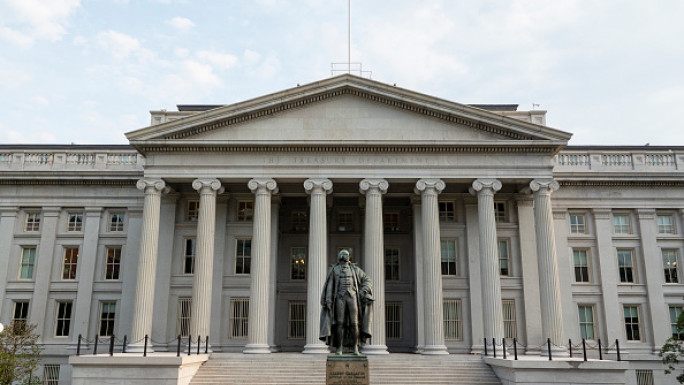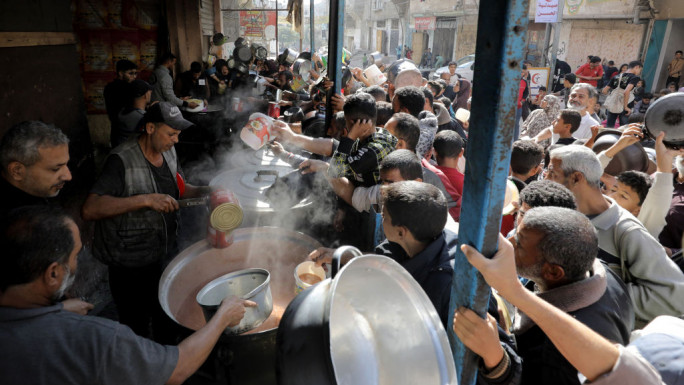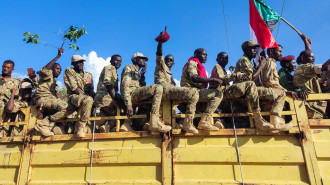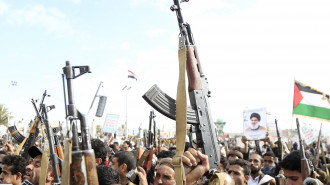Where's Douri?
It has been one of the big mysteries of the Iraq war – where is Izzat al-Douri?
Douri - known for his beret and bright orange moustache - was the vice chairman of the revolutionary command council during the Saddam Hussein-era.
When Hussein's regime crumbled following a US-led invasion of the country, Douri went on the run and became one of Iraq's more famous war fugitives.
While the upper echelons of the Baath party have all been locked up, fled the country, or killed, Douri's whereabouts is unknown. For 13 years he has evaded Iraqi security services and US intelligence.
Humble beginnings
Al-Dour, near Tikrit. Douri was born here in 1945 to an impoverished family, and during his childhood he studied Sufism, which is widespread in the area.
When in power, he would try and promote Sufi Islam in the government's religious institutions.
Douri did not do well in school and failed his high school examinations several times. He gave up academia and started work as an ice block seller, a popular job in the 1960s when refrigerators were a luxury for the rich in Baghdad. Baath party members have later said the job was a cover for Douri's secret political activity.
Lufti al-Qazzaz, a former resident of the eastern Baghdad district of al-Fadl, remembers Douri in the early 1960s. The ice seller was a young and aspiring member of the Arab Socialist Baath Party.
The revolutionary party was trying to wrest control of the country from the president at the time, Abd al-Salam Arif. Douri moved between al-Fadl and al-Adhamiya districts of Baghdad, until he was assigned to place in the National Guard.
Not long after, Arif disolved the group and threw Douri in prison until 1966.
Douri came to prominence during the 1968 October revolution, when the Baath Party took control of Iraq and brought Arif's rule to an end.
It has been said that Douri was in one of the tanks that stormed the republican palace in Baghdad.
Qazzaz who stayed in touch with Douri, said the new rulers of Iraq assigned Douri to various semi-important positions. He climbed the party ladder, starting as an official who oversaw agricultural matters until he became the minister of agriculture.
Later he would be appointed minister of interior and then step up to take one of the most important positions in the country, vice chairman of the revolutionary command council.
Douri carried out numerous investigations into suspected upheavals in the Baath party, and spotted supposed conspiracies. Most of Douri's investigations ended in the execution of the accused.
This instilled confidence in Saddam Hussein who later would award Douri with the position of deputy commander-in-chief of the armed forces.
Theory one - Sufi hideaway
Qazzaz told al-Araby al-Jadeed of Douri's close knit relationship with most of the Sufi religious leaders in the country. He believes this is the key to understanding how he was able to evade capture for so many years.
He says it is likely that the Qadiria Sufi order hid Douri in dozens of their small sanctuaries and hospices in northern Iraq.
Douri was moved from location to location every two weeks, according to security conditions. Sources close to Douri said he also likely stayed in Kurdistan for a lengthy period in the first years of the US invasion.
His supporters kept him safe not just from the US and Baghdad government, but also militant groups such as al-Qaeda and the Islamic State group (IS, formerly known as ISIS).
Douri leads the Army of the Men of the Naqshbandi Order, what was a powerful organisation in Kirkuk and Mosul. It had clashed on numerous occasions with more hardline Islamist organisations.
But Qazzaz said that the US's $10 million prize on Douri's head failed persuade anyone in his inner circle to betray him. He still moves around Iraq with ease, despite his old age and suspected leukaemia.
| Most of Douri's investigations ended in the execution of the accused. |
Theory two - Refuge in Syria
Adnan al-Hajj, a political analyst, said that his close study of leaked statements and excerpts of high ranking officials in the dissolved Baath party indicate that Douri was smuggled into Syria. He suggested Douri went through the Rabia border crossing in Nineveh Province during the US occupation of Iraq.
Douri was in hiding in Kirkuk and Nineveh in 2003, Hajj speculated, until he was brought into Syria in 2004 in cooperation between Iraqi Baathist leaders and the Syrian government.
Damascus gave hundreds of Iraqi Baathist leaders sanctuary, he says, and the Syrian leadership believed they could use Douri as a bargaining chip with the US and future Iraqi governments at a later date.
"An Iraqi Baathist leader going by the handle Comrade Abu Urouba al-Murshidi reassured his colleagues at the time on the Basra Network, a Baathist internet forum, that Douri was in a safe place among his comrades and brothers," said Hajj.
Other believe that Douri was in the Syrian capital during the first stage of the war, while other believe he was taken to al-Qardaha in Latakia, the hometown of the Assad dynasty.
Hajj said Douri was given the rank commander-in-chief and then became president of Iraq when Hussein was executed in 2006 by the Baathists.
However, during this time Douri fell out with Damascus after it supported a rift within the Iraqi Baath party, and supported a rival faction led by Mohammed Younis al-Ahmed in 2007.
According to former Baath party members Assad then sent Douri to the Yemeni capital of Sanaa where his trail goes cold.
Most of the recordings of Douri's – both audio and video – were filmed in Syria and Yemen, he says, but were doctored to make it appear that he was filmed in Babil or other parts of Iraq.
He said, this has led to a "disinformation campaign" by the Iraqi police and politicians who have been competing to announce Douri's killing or capture.
Ten times did authorities announce that Douri was out of the game, and the last story alleged that he died in Tikirit during US bombing of the city.
But the Interpol fugitive soon confirmed that he was alive and well when he released a recording congratulating Arabs on their unity during Operation Decisive Strom.
Scenario three - The body double
Kurdish author and journalist Nouzad Sabah said he is convinced that Douri is dead. He believes the fugitive died seven years ago of complications caused by old age and leukemia. Sabah says that a 2005 Baath party obituary is irrefutable proof that he is dead.
A video of Douri released in 2012 was the work of editing tricks, hi-tech cosmetics, excellent acting and voice impersonation skills, he says.
The double of Douri was done under the supervision of groups that want to convince the world that he is still alive.
"The Baath Party may have regretted announcing Douri's death so quickly and then later wanted to use Douri's ghost to ridicule Iraqi government leaders and figures that rejoice at the reports of his death of capture," he alleged.
"Every time he comes back to life as an invincible leader and hero in spite of the efforts by the Iraqi police, and US army and intelligence, to capture him."
The riches of Baath party members have allowed them to finance activities against the state, including armed operations.
The money has also allowed them to hire expensive experts to find Douri lookalikes or use cosmetics to create doubles of him. They have previous experience of this by making Saddam decoys when he was ruler of Iraq, so it would be possible with Douri too.
Sabah said that regardless of the final fate of Douri he has finally been able to play the role of leader among supporters of the Baath party after Saddam Hussein’s demise.
This article is an edited translation from our Arabic edition.





 Follow the Middle East's top stories in English at The New Arab on Google News
Follow the Middle East's top stories in English at The New Arab on Google News


